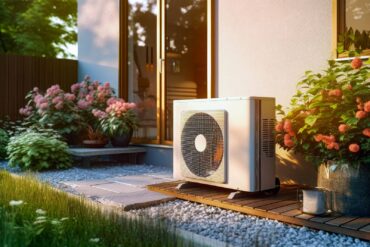 As temperatures dip, homeowners are shifting their attention to keeping their indoor spaces comfortable during the cooler months. However, many conventional heating and cooling systems can be very inefficient to operate, causing your utility bill to soar — especially in the winter.
As temperatures dip, homeowners are shifting their attention to keeping their indoor spaces comfortable during the cooler months. However, many conventional heating and cooling systems can be very inefficient to operate, causing your utility bill to soar — especially in the winter.
What’s the solution to creating a comfortable home that’s also energy-efficient and supports a healthy environment? One option that homeowners in colder climates may want to consider is a hybrid system that pairs an electric heat pump with a furnace as a backup heat source.
What Is Hybrid Heating?
A hybrid HVAC system uses a heat pump as the primary heat source, which is paired with a furnace for supplemental heat only in the coldest months. Heat pumps “move” heat from one source to another, as opposed to “creating” heat, making them highly efficient systems that reduce energy use by as much as two-thirds when compared to conventional heating. However, at very cold outdoor temperatures, many air-source heat pumps need to rely on backup heating, which is either electric-resistance strip heating or fuel-combustion heating from a furnace.
Because electric resistance uses a significant amount of electricity, it is very inefficient and can place a large strain on the electric grid. This can create more harmful carbon emissions than utilizing a gas furnace for the limited periods that backup heating is needed — making hybrid systems a very sustainable solution.
“A dual-fuel heat-pump system is a proven, sustainable way for homeowners to heat and cool their home year-round while reducing their emissions and cutting energy costs,” said Manuel de la Fuente, vice president and general manager of Johnson Controls-Hitachi North America.
Reliable Comfort in Extreme Cold
Hybrid heating systems work similar to how a hybrid car uses gas or electric automatically based on whatever is most efficient. In very cold weather, a hybrid heat pump with a gas furnace for backup heat will not only ensure consistent and dependable indoor temperatures but also have lower carbon emissions and operating costs than a heat pump utilizing electric resistance for backup heat.
For example, the Hitachi air365 Hybrid dual fuel system combines two heat sources: an external Hitachi Mini VRF heat pump and either your existing gas furnace with an attached dual fuel module, or a new model, such as the YORK YP9C Modulating Gas Furnace. When the air365 Hybrid system is in heating mode, a smart sensor monitors the outdoor temperature. If it reaches a temperature where the heat pump cannot efficiently meet the indoor heating demand, it automatically switches from the heat pump to the furnace.
Rebates and Tax Credits
Many federal, state and local incentives are available now to encourage heat pump adoption and significantly reduce the upfront costs of new equipment. For example, the Inflation Reduction Act (IRA) expanded incentives for high-efficiency HVAC equipment, including the 25C tax credit. Many electric utilities also offer incentives for customers to install high-efficiency heat pumps, and these incentives can usually be combined with federal and state programs. Climate policies and incentive programs differ from state to state and even city to city, so rebate amounts and qualifications may change depending on homeowner location.
To find a Johnson Controls-Hitachi Air Conditioning contractor, visit HitachiAirCon.com, and to learn more about Hitachi air365 Hybrid dual fuel system, visit HitachiAirCon.com/air365hybrid.






















Comments